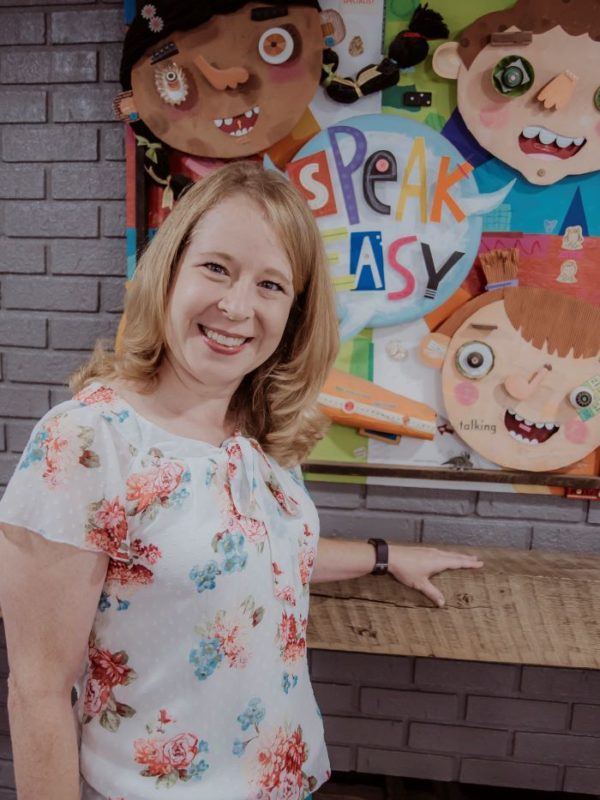By Guest Blogger Julie Casey owner of SpeakEasy Therapy and practicing speech pathologist
Do you have tons of new toys from Christmas sitting around? Of course you do! If your child struggles with their speech or has diagnosed speech or language delays, it might be time to put those toys to work! You may not realize it, but many toys can help reinforce good speech habits.
While screens are always fun, our kids are bombarded with digital play ideas and endless access to technology. It’s one reason why I never use screens in therapy sessions. I use books, games, crafts, and therapeutic play.
Below is a list of commonly received toys for both boys and girls and some ways you can “play” with your child to help reinforce good speech habits.
 BUILDING TOYS
BUILDING TOYS
Examples: Legos or Blocks
Ways to Use:
- Practice saying a speech sound word for each prong on the Lego block
- Name an item in a category for each hole on the block (e.g., for a block with four prongs, the child may name four animals)
- Practice giving/following directions to build, practice sequential directions with words like first/next/after/last,
- Practice position words such as under/in front of/next to/between
FIGURINES
Examples: Dolls, Mr. Potato Head, Action Figures
Ways to Use:
- Reinforce good speech habits by practicing identifying and/or pointing to body parts, clothing, colors,
- Learning pronouns (e.g., “he needs arms” or “she is walking” or “her hat fell off!) or verbs/feelings (e.g., “baby is crying/eating/drinking/sleeping/hungry/thirst/sleepy/sad”)
- Following directions (e.g., put the blue shoes on Potato Head, give the baby some peas, etc.)
PLAY STRUCTURE TO REINFORCE GOOD SPEECH HABITS
Examples: Tents, Playhouse, Treehouse, Kitchens
Ways to Use:
- Pretend play helps your child understand the power of language by actively experimenting with the social and emotional roles of life and create storylines.
- If your child is playing with others, it is considered “cooperative play”, which teaches how to take turns, share responsibility, and creatively problem-solve.
- Let your child describe how you use an item (i.e., what do you do with a knife? What can you use to eat soup?)
- Learning cause and effect (e.g., closing the zipper on the tent, making a bowl fall off the table, ringing the doorbell on the playhouse, etc),
- Identifying and/or using opposites (e.g., under/over, hot/cold, open/closed, top/bottom, full/empty)
- Learning associations (e.g., what goes with a sleeping bag? What goes with birthday candles?)
- Adding words to utterances (e.g., when a child says, “apple,” the adult can respond “red apple” or “crunchy, red apple! Mmm!”)
 STICKER SETS
STICKER SETS
Examples: Removeable Sticker Sets
How to Use:
- Practice position words (e.g., under/next to/in front of/beside)
- Making inferences (e.g., for a fire scene, how do you think the fire started? How did the fire engine get to the building?)
- Learning possessives (e.g., her dress, his shoes, tiger’s tail, bowl’s lid, etc)
- Vocabulary building (e.g. introducing new words by way of a previously learned word)
- Learn categorizing by creating categories for stickers to be placed within
- Create a story from the stickers by using a sticker book
VEHICLES/ THINGS THAT MOVE
Examples: Miniature Cars, ”Pull back” Cars, Car Ramps
How to Use:
- Position words (e.g., down the ramp, under the garage)
- Descriptive words (e.g., faster than the motorcycle, louder than the fire engine)
- Part-to-Whole connections (e.g., ladder on the fire engine, wheels on the car, lights on the police car, etc)
- Types of vehicles (e.g., emergency vehicles, trucks, farm vehicles, bikes, etc)
- Practicing speech sounds to count down a race (e.g., “three-two-one!” for the /th/ sound) to reinforce good speech habits
CRAFTS TO REINFORCE GOOD SPEECH HABITS
Examples: Craft Kits, Slime Kits, etc.
How to Use:
- Help the child follow instructions and stress the importance of proper sequencing
- Discuss why something happened in the order it did
COMMUNICATION TOYS
Examples: Toy Phone (younger) or Walkie Talkies (older)
How to Use:
- Encourages social skills such as appropriate phone greetings, turn taking
- Easy to incorporate practicing speech words
- Ask them to describe something such as telling a friend about their birthday party or ask them to do something such as ordering a pizza.
BOARD GAMES
Preschool Examples:
- Sneaky Snacky Squirrel
- Pop-Up Pirate – Helps with color awareness and counting
- Barnyard Bingo
- Pop the Pig
- Where is Howie’s Owie? – Great for learning body parts
School-age Examples:
- Guess Who – Incorporates answer questions, understanding same/different, and using descriptive concepts such as long, short, fat, skinny, old, young, etc.
- Articulate for Kids! – Encourages descriptive language and helps with forming sentences.
- Sequence – Matching skills
- Pickles to Penguins – Work linking
- Apples to Apples Jr. – Making comparisons
All games are great for increasing listening skills, as well as how to learn to follow directions and take turns. It’s intentional, hands-on learning activities that keep our kiddos actively engaged throughout our entire session and has them looking forward to getting together again. Toys and games can be easily incorporated into a daily routine for families without it feeling like additional work or a burden.
Additionally, any of the toys or games mentioned above can be used with pairs or in groups to help promote social skills including eye contact, topic initiation, topic maintenance, topic closure, personal space, sharing, asking and answering questions. So, keep that in mind if you have other children in the house or additional family that would like to join in.”
 If you’re worried about your child’s speech or language skills, do not hesitate to contact SpeakEasy Therapy right away. Julie will provide a free, over-the-phone consultation to determine if your child is likely experiencing speech delays and advise on next steps. Call or email our office so that we can talk through these concerns and determine if the next best step is to set up a speech-language screening and possible evaluation. It’s a small investment that can provide answers to your questions and will either help to eliminate a concern or put you on the path towards resolving one.
If you’re worried about your child’s speech or language skills, do not hesitate to contact SpeakEasy Therapy right away. Julie will provide a free, over-the-phone consultation to determine if your child is likely experiencing speech delays and advise on next steps. Call or email our office so that we can talk through these concerns and determine if the next best step is to set up a speech-language screening and possible evaluation. It’s a small investment that can provide answers to your questions and will either help to eliminate a concern or put you on the path towards resolving one.
If you are unsure where to find the time and the place for speech therapy – don’t be. SpeakEasy Therapy makes it easy to fit speech therapy into anyone’s busy schedule by offering their services in the following ways.
Virtual
SpeakEasy Therapy offers speech evaluations and therapy via Zoom.
In-School
SpeakEasy Therapy makes it easy to work in speech therapy by working with you and your child’s teacher to determine a good time and place to meet with your child during their school day.
At-Home
Sometimes having a speech pathologist come to your home makes the most sense for your schedule and your family.
SpeakEasy Therapy, PLLC has been in operation for eleven years and Julie Casey, Owner and Speech Pathologist, has been certified and practicing for over twenty. Each speech pathologist with SpeakEasy Therapy, PLLC is licensed with the North Carolina Board of Examiners for Speech-Language Pathologists and Audiologists and is a certified member of the American Speech-Language-Hearing Association (ASHA). To learn more, visit their Facebook page or contact Julie Casey directly at (336) 946-2493 or info@speakeasytx.com.
*Sponsored by SpeakEasy Therapy PLLC










